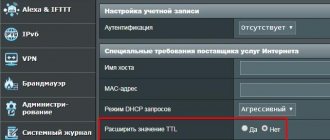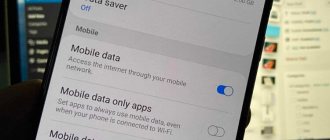From November 10, 2021, the mobile operator MTS introduced a daily payment for distributing the Internet from a smartphone to other devices via Wi-Fi, Bluetooth or USB. This applies to the “Smart Unlimited” tariff plan. Now, for the fact of distributing the Internet from your phone, you will be charged 30 rubles per day. Some people will say that 30 rubles is not such a big price to pay for the opportunity to use the Internet on different devices. But that's not the point. At the beginning of the appearance of this tariff plan, the distribution of the Internet was free and many subscribers fell for the advertising and changed their old tariffs in favor of “Smart Unlimited”. It was such a marketing ploy. Everything was fine until MTS decided to introduce payment for distribution. Such actions by MTS led to dissatisfaction among subscribers and many began to think about how to bypass the restriction on Internet distribution or switch to other operators. But this makes no sense, since their prices are even higher.
Where is the way out of this situation? Operators often deceive their subscribers, so why not repay them in kind. In this article we will look at how to distribute the Internet from a smartphone to other devices for free and without the knowledge of the operator. All methods have been tested and proven to work.
IMPORTANT
This technique is relevant for different tariffs that limit the distribution of the Internet.
What is TTL and how to find it on your phone
TTL (Time to live) is a limited period of validity of an IP packet or the number of hops from one router to another that it can make without destroying the data packet. The purpose of the technology is to prevent an IP packet from endlessly wandering around the network between different routers.
This parameter is essentially an ordinary numerical value from 1 to 255. However, it is by it, or rather by changing its initial value, that mobile operators can quickly and accurately determine the subscriber distributing the Internet.
You can find out the value of the parameter on your device using the Terminal Emulator program.
To do this, having entered it, you should type the line: cat /proc/sys/net/ipv4/ip_default_ttl. It will display the requested value.
How to change TTL on Android
The capabilities of modern smartphones allow you to share access to the mobile Internet with other devices using a Wi-Fi, Bluetooth or USB module.
How to change TTL on Android
Contents - How to change TTL on Android
- What is TTL and why is it needed?
- Is it possible to change TTL?
- How to find out TTL on a phone?
- How to change TLL on rooted Android?
However, not everything is so simple - greedy mobile operators that provide “unlimited” service packages often limit the distribution of the Internet. To discover connected devices, they use the TTL parameter value, which is automatically sent to their main server. In this instructional article, we will understand what TTL is in a phone and how to change it to bypass Internet distribution restrictions.
What is TTL and why is it needed?
TTL (Time to live) - the maximum period of life of a data packet or the maximum number of its transitions from one device to another. In computer networks, this parameter is an ordinary numerical value in the range from 0 to 255. Its main purpose is to prevent a set of digital information from endlessly “wandering” across the network. As you move between different routers, the TTL setting is constantly changing.
For most mobile devices (iOS and Android), the initial TTL value is 64, and on Windows computers it starts at 128. Each transition through the wireless communication channel reduces this number by exactly 1. When, after many jumps from one client to another, the TTL becomes equal to 0, all data in the packet it accompanies is automatically destroyed.
Since the TTL value is always returned to the original destination (the provider), it can find out whether the traffic was passed through third-party routers, that is, other devices.
Cellular operators use TTL to limit access to unlimited Internet when their client connects to it from several different gadgets. After an Android smartphone switches to modem mode, it transmits traffic with a TTL parameter of 64. Devices that receive this information automatically reduce the initial TTL by 1. As a result, the provider receives packets marked with a lifetime of 64 and 63, after which it blocks the network. In most cases, this makes it impossible to distribute the Internet via Wi-Fi.
Is it possible to change TTL?
As you might have guessed, in order to unblock access to third-party devices to the mobile network, you need to properly configure the TTL value. On Android this is done in several ways, depending on whether the smartphone is rooted. You also need to select the device on which the TTL parameter changes will be made: the one distributing traffic or the one receiving it.
Next, we will consider exclusively the Android mobile platform.
How to find out TTL on a phone?
It is worth noting right away that it is almost impossible to gain access to an unlimited number of third-party connections to the mobile network without administrator rights. To find out the TTL value on your phone, follow the instructions:
1. First you need to install the Terminal Emulator application.
2. After running this small utility, the command console will open, into which you must enter the following line: cat /proc/sys/net/ipv4/ip_default_ttl
3. The result will be the TTL value.
How to change TLL on rooted Android?
Having received administrator rights (root) on Android, you need to install one of the file managers, for example, ES Explorer. Next, you will need to activate airplane mode on your smartphone to temporarily interrupt the connection to the network. Now launch Terminal Emulator and navigate to the file at: proc/sys/net/ipv4/ip_default_ttl . It contains the value of the TTL parameter, which you can change at your discretion. By saving the new number and rebooting the phone, you can safely distribute the Internet.
There is a more comfortable way to set up multiple connections to a mobile network. To implement it, you will need to download a special TTL Master application. After starting the program, you can immediately see the current value of this parameter and configure it for effective distribution to both mobile devices and Windows computers. After rebooting the smartphone, you don’t have to worry that the mobile operator will somehow find out about the overall use of its traffic.
Changing TLL on Android is a simple task for rooted smartphone users, who can bypass Internet sharing restrictions in a couple of clicks. If there are no “super rights”, then with a high degree of probability nothing will come of it.
Difference in device operation with standard TTL and changing it
A smartphone that does not distribute the Internet transmits to the operator the standard “lifetime” value, which is usually 64. As soon as the device starts sharing its traffic, its value will change by exactly one and become 63.
It follows from this that the distributing gadget sends a data packet with the value 64 to the receiving device. And the smartphone that received the information automatically reduces it to 63 and transmits it to the mobile operator.
That, in turn, becomes aware of the unauthorized distribution of traffic. In such situations, the Internet of the subscriber carrying out the data transfer is blocked, and funds may be debited from his account.
However, if you change the digital value of the parameter or make it constant, you can avoid problems with the operator, since he will not be able to record the fact of the violation. Since after correcting the data, the standard combination will be sent to the operator, despite the fact of distribution.
Changing TTL with root rights
Changing the digital value of a parameter if you have administrator rights is quite easy. You can check their availability using the free Root Checker application, whose simple interface allows you to get the necessary information absolutely intuitively and quickly.
If root access has been confirmed, you can proceed directly to changing the “lifetime” of the package.
To do this, you can use ES Explorer or the TTL Master program.
When working with the second program, you should adhere to the following algorithm:
- Download the application from the Google Play store and launch it.
- In the “Enter TTL” column, indicate the desired digital combination and click on “Apply”.
In addition to this application, you can also use ES Explorer. To do this you need:
- Install the program if it is not on the gadget.
- Activate “Airplane Mode” or “Standalone Mode” depending on your phone model.
- Launch Explorer and type the line – proc / sys / net / ipv4 / ip_default_ttl.
- Open the file using any program that opens text, and change the original digital combination to the desired one.
- Save the new data and close the file.
After these manipulations, you can distribute by disabling “Airplane Mode”.
Is it possible to change TTL without root rights?
You can check without first acquiring rights. It is important to understand that the operation is not available everywhere. To check and install the required changes, you need to download Terminal Emulator. After that, to change TTL android, the following sequence of actions is performed:
- The application opens.
- Type cat /proc/sys/net/ipv4/ip_default_ttl.
- If there is an optimal version of the device, the original TTL will be presented.
- The parameter presented to your attention is increased by one through the patch.
- It needs to be installed on gadgets that require connection.
- Finally, you need to reboot the devices and check the result obtained to see if the indicator has been changed and fixed.
This TTL option is used quite rarely. If the user has received restrictions on the traffic used or the network speed limit, he is required to gain access through rights.
Is it possible to change TTL without root rights?
Changing the maximum lifetime of a package without administrator rights is possible, but doing so is quite problematic. In addition, not every smartphone will allow this manipulation.
To change the parameter without root rights:
- Download the Terminal Emulator application and log into it.
- In the pop-up window, enter the line: cat proс/sys/net/ipv4/ip_default_ttl.
- Change the standard indicator, if possible on a specific gadget.
- Repeat the procedure with all devices that will connect to the distribution.
- Restart all gadgets.
This method works extremely rarely, so it is better to change the parameter with root rights.
By changing the standard value of the “lifetime” of an IP packet using simple manipulations, you can bypass the ban of most mobile operators on distributing Internet traffic. This adjustment will allow you to share the Internet with your friends without fear of being caught violating it.
However, before carrying out it, it is recommended to root the gadget, this will make the procedure easier and minimize the risks of errors.
Most telecom operators limit the distribution of Internet from a smartphone. In this case, traffic is either completely absent or available at a different price (often greatly increased). Bypassing such restrictions is possible. The proposed material will explain how to change TTL on Android without root rights and if you have them.
The concept of TTL?
Its purpose is to prevent digital information packages from eternally “wandering” across the Internet. The “lifetime” indicator changes all the time when moving between different routers.
TTL is actually the maximum service life of a package with information or the maximum number of times it can be moved between gadgets (the English abbreviation is Time to live). In more detail, for a computer network this indicator corresponds to the range 0-255.
Most Android gadgets >
Since the TTL indicator is transmitted to the provider each time, it is able to see whether the data flow passed through “extra” routers (i.e. other devices).
TTL is used by providers to limit unlimited Internet and prevent connections to it from several different sources. After an Android-based smartphone switches to distribution mode, information is transmitted through traffic at TTL = 64. The device receiving the data packet automatically reduces the base level by 1. And the provider receives a packet marked equal to 64 and 63. As a result, the telecom operator blocks this network. Basically, this does not make it possible to distribute the Internet via Wi-Fi.
What is TTL
TTL (Time to Live) – the lifetime of a data packet on the network. Every transaction that takes place on the Internet involves data. Registration on the site, authorization, messaging and everything else is done thanks to data that is divided into parts into packages and contains the necessary information.
How does this magical Time to Live relate to data? The fact is that the TTL number allows you to relieve the network from congestion. In simple words, this number records the number of places (network nodes) that a certain data packet can visit. For example, if TTL = 64, a packet can only go to 64 places. Moreover, when transporting it from one device (or network) to another, this number decreases by one. If the TTL becomes 0, the data packet can no longer be sent anywhere. If TTL did not exist, then data could travel across the network as many times as desired, and this could cause big problems (overloads) and even give hackers more opportunities to carry out various attacks.
Time to Live numbers are now actively used by mobile operators. How often have you encountered the fact that you could not distribute the Internet from one device to another? More precisely, they could, but would they have to pay extra for it? But how exactly does this number help the operator?
The fact is that when creating various requests, the package is formed with a given Time to Live. For example, after turning on the mobile Internet, you decide to visit the site. A smartphone or any other device from which you access an Internet resource creates a request, which is a data packet.
And this packet immediately after “birth” receives a TTL number. The packet is transmitted to the site through the operator, who already has information about this TTL. And if the TTL matches what it was when the package was created, the operator gives permission and the site is entered. But the TTL number may differ from what it was at the time the package was created (be smaller).
As was justified earlier, this happens when the packet has already visited some place, that is, it has been transmitted somewhere. Now we need to remember how network access is generally achieved for devices that share the Internet. Since they are not directly connected to the network, they send their data packets with a TTL number to the distribution device, which has direct access. And this is where the TTL becomes less than the value that was when the packet was formed. The operator sees this and understands that the Internet is being distributed to other devices. Let's look at an example:
- Smartphone A can be used as a distribution device;
- We turn on mobile data transfer to A and a Wi-Fi hotspot;
- We connect to A from smartphones B and C;
- We are trying to log in, for example, to VKontakte from smartphones B and C. Requests (data packets) are generated that receive unique TTL (let it be 64 for B and 128 for C);
- Since B and C do not have direct access to the Internet, they conduct all their transactions through smartphone A. We transmit packets from B and C to smartphone A, the TTL decreases from 64 and 128 to 63 and 127;
- Smartphone A has received the data and transmits it to the VKontakte website under the “supervision” of the operator, who sees the data about the packages. The operator sees that the TTL numbers (63 and 127) do not match those that were at “birth” (64 and 128). This means that the packets have already been transmitted somewhere, which means that distribution is taking place. “Comrade A, we don’t give access to B and C, pay for the distribution.”
Why is TTL replacement needed?
When distributing the Internet using an Android-based smartphone, you can note that some devices easily connect to the network, and when others join, you immediately receive a warning (message) from the telecom operator about a decrease in the distribution speed or an increase in the cost of the service. The reason for these warnings is the differences in TTL indicators between devices (distributing the Internet and receiving this signal).
When such a problem occurs, the user immediately thinks of how to change the TTL on a phone without root rights to Android. As a rule, there will not be many people willing to purchase a more expensive package without using up the entire Internet limit in the previous one. The simplest way is to change the TTL on the signal receiving device, i.e. computer. You can also change this parameter on the gadget that distributes. However, this may lead to access problems for devices that previously connected without problems.
Checking superuser rights on a smartphone
To change the “lifetime” value of an Android device, you must obtain administrator rights (root rights). Additional software will help with this, which can be downloaded for free on Google Play. Popular applications such as Root Checker or Terminal Emulator will allow you to determine your existing superuser rights. The interface of the first application is very simple and allows you to check intuitively. When using the second one, you must enter “SU” in the command line, which will help determine whether you have root rights. The # or $ icons shown will confirm a positive result.
Changing TTL with root rights
The best method for changing the TTL indicator (regardless of whether the device is receiving or distributing) is to use a special application. All such programs can only be used with root rights. Accordingly, the device must be rooted in advance.
The best assistants in this are the TTL Master and ES Explorer programs. Working with them is simple and convenient.
TTL Master App
TTL Master (Yota Tether TTL) is a program that helps replace the “native” TTL with another, allowing you to bypass provider restrictions. The program helps in working with any telecom operator. You can automatically change the TTL by rebooting the device.
The main advantage of TTL Master is its simplicity. The steps are simple:
- You need to go to Google Play, find the application and install it on the gadget on which the TTL indicator will change.
- By launching the Wizard, the user will have access to the real TTL indicator and the column where the changed indicator needs to be entered. We change.
- Then you need to reboot the device.
These simple steps will help remove all speed limits. We remind you that you cannot use ttl master without root rights.
ES Explorer app
Changing TTL using ES Explorer will take longer than using the previous program. For this you need:
- Turn off all network connections on the device by activating the “Flight” mode (in some gadgets - “On an airplane”).
- Turn on ES Explorer and type the following combination - proc / sys / net / ipv4 / ip_default_ttl .
- Open the final file using a convenient text editor, and replace the specified ttl indicator with another one. After that, close the file, saving the changes.
- Disable “Flight” and activate distribution.
How to change TLL on rooted Android?
Having received administrator rights (root) on Android, you need to install one of the file managers, for example, ES Explorer. Next, you will need to activate airplane mode on your smartphone to temporarily interrupt the connection to the network. Now launch Terminal Emulator and navigate to the file at: proc/sys/net/ipv4/ip_default_ttl. It contains the value of the TTL parameter, which you can change at your discretion. By saving the new number and rebooting the phone, you can safely distribute the Internet.
There is a more comfortable way to set up multiple connections to a mobile network. To implement it, you will need to download a special TTL Master application. After starting the program, you can immediately see the current value of this parameter and configure it for effective distribution to both mobile devices and Windows computers. After rebooting the smartphone, you don’t have to worry that the mobile operator will somehow find out about the overall use of its traffic.
Changing TLL on Android is a simple task for rooted smartphone users, who can bypass Internet sharing restrictions in a couple of clicks. If there are no “super rights”, then with a high degree of probability nothing will come of it.
TTL android is a question whose answer will be useful to users of devices running on this OS. With the correct settings, you can regulate the distribution of traffic. You can achieve a similar result by using third-party utilities and competently regulating the functionality of the device. The article provides information about what it is, for what purpose the function is used, and how to change previously established indicators.
Is it possible to edit TTL without root rights
You can change TTL without these rights, but not on every device running Android. You should install the Terminal Emulator for Android application on your gadget.
After installing the program you must:
- Activate the application and dial the following combination - cat / proс / sys / net / ipv4 / ip_default_ttl .
- If the device model allows you to make adjustments without administrator rights, then the original TTL indicator will become available. You need to increase it by one. The same change must be made in all devices connected to the network.
- Reboot all equipment and then evaluate the result.
Although this method works, it is effective in rare cases. Therefore, it would be more reliable to obtain root rights and be guaranteed to bypass traffic restrictions by the provider.
Possible mistakes
The list of possible errors and malfunctions that may occur when replacing TTL on Android with and without root rights is quite extensive. It is physically impossible to describe them all. They depend on the manufacturer and model of the device, the provider, the characteristics of the device to which the distribution is carried out, etc. There can be many reasons, and it is quite difficult to foresee them all.
We can recommend the following:
- If the user has an understanding of the issue at hand and is not afraid of harming the device, then it is worth seeking help from one of the specialized sites or forums. For example – https://4pda.ru/.
- If there is not enough knowledge in this area, and there is a risk of doing something wrong, then the best solution would be to seek help from a specialist.
To summarize, we hope that the above material will be useful and will help bypass the restrictions of cellular operators, significantly saving your “hard earned money”.
The easiest way to distribute the Internet to other devices is with a superuser account, which gives extended rights to use smartphone functions. But Root rights have a lot of pitfalls, and not every user will understand and be able to use them. Therefore, we will consider all the options on how to change TTL on Android without Root.
How to get root rights
Depending on the operating system version and manufacturer, obtaining methods may differ. If earlier (before Android 4.4) it was enough to install the program and press 1 button, now (starting with 5.0) you will have to tinker with the computer. And yet, there is a somewhat generalized algorithm that will help you get root on almost any Android device.
- The first stage is preparation. You need to open developer options and enable USB debugging. At the same stage, you need to make sure that the memory card in the device is working properly;
- The second stage is downloading all the material. The material means files for unlocking the bootloader (if necessary), ADB drivers (search on the official website) and USB (search on the manufacturer’s website), a file for installing custom recovery, as well as a file (usually an archive) that is the “key” for getting root;
- The third stage is installing drivers, checking the connection between the PC and the device;
- The fourth stage is unlocking the bootloader, installing custom recovery and launching it;
- The final, fifth stage is flashing the required file, which gives root access.
Where to look for material for your device? There are many sites on the Internet where you can find firmware and a bunch of other useful files specifically for your device. Alternatively, you can go to w3bsit3-dns.com. There you can also find detailed instructions on flashing or getting root.
What is TTL
TTL or Time to live is a criterion for determining the time of using an Internet package. ISPs use the time-to-live value to monitor unauthorized connections of other devices and disable network access. If you connect your smartphone to your computer via USB or Wi-Fi, or try to connect a family member to your tariff, the operator will immediately know about the attempt and take action. Usually this is an additional payment or a traffic cutoff. To figure out how to change TTL on Android without Root rights, we’ll find out in more detail how the operator monitors connection attempts.
TTL operating principle:
- Initially, TTL is 64 (in some devices 128).
- As soon as the access point is turned on, the lifetime changes.
- Traffic from the main device is TTL-64.
- With an additional connection there is already one less unit, TTL-63. That is, with each transition over a wireless network, TTL loses one value.
- After “wandering” on the Internet, the package returns to the provider.
The operator monitors such discrepancies and punishes subscribers.
What is TTL and why is it needed?
TTL – period of activity of the set of information received from the IP protocol. Using the indicator, the operator company is able to limit or block access to traffic from the equipment to which the Internet was temporarily transferred.
The main purpose of the described option is to detect unauthorized connection to traffic. This result is achieved quite easily. The following sequence of actions is performed:
- The point on the smartphone is turned on to provide access.
- A special information transmission package automatically changes the level.
- The transmission is carried out with a changed access parameter.
- From the device that was connected to a free accessible point, the installed packet is transmitted with a different value.
After performing such steps, the level automatically loses one previously accepted parameter unit. After this, the provider receives two indicators from one device; they need to be saved and recorded using the fix option.
When to change TTL
Unlimited Internet tariffs appeared 5 years ago. To prevent people from using traffic for distribution to a computer or smartphone, operators came up with a control system - TTL tracking. Users responded immediately and learned to change the TTL value. Is it always necessary to change the TTL on Android without Root?
Those who have already tried changing TTL to Android without Root have encountered a situation where, when distributed to some smartphone models, traffic flows freely, but problems arise with some. In particular, SMS messages are received from the operator with a request to activate a special service to expand TTL options or for an additional payment.
Such discrepancies between devices occur due to different TTL values. More often this happens between a smartphone, where TTL=64, and a laptop, where TTL=128. In this situation, it is better to change the TTL indicator on the computer and fix the value so that after rebooting the device the settings are not lost.
What are advanced account rights
Not all users know what Root rights are and what opportunities they open for the user. This is an account that allows you to make any transactions on your smartphone. Superuser mode is needed to customize the gadget for yourself or to open applications that do not work.
To check if your device is Rooted, download the Root Checker and Terminal Emulator applications. All you need to do is install and run the scan. If a superuser profile is detected, the program will issue a corresponding notification.
Ways to change TTL without superuser rights
This action does not work on some models. To do this, download “Terminal Emulator for Android”. A program is a set of software tools that make it easier for a person to interact with a computer.
How to change TTL on Android without Root:
- after installation, enter the special command: cat /proc/sys/net/ipv4/ip_default_ttl
- if changes are available in the smartphone, a special field with the primary TTL value will appear;
- add 1 to the indicator to fool the provider's technology.
To complete, restart your devices and reconnect to the Internet. If you were unable to bypass the restrictions, funds are debited, or traffic is disconnected, enable Root rights.
Changing TTL with Root rights
The easiest way to capture TTL is with a rooted smartphone. A root profile gives the user chief administrator rights and the ability to perform any manipulations.
Today, Russian operators have special tariffs or additional services for sharing the Internet. But such options are paid or have restrictions on the amount of information transferred. Therefore, subscribers are looking for ways to bypass TTL accounting, which we will consider below.
Many popular methods for changing TTL only work until the smartphone is rebooted, then the indicators return to their original value. It is important not just to enter another number, but also to record the value.
On Android using apps
If your smartphone is rooted, the easiest way is to use “TTL Master” and “ES Explorer”. To work with them, you don’t need to have any IT knowledge; just download and run the utilities.
TTL Master
The program is available for download. Download TTL Master.
Instructions for using Master TTL:
- Download to your smartphone.
- After installation, the current TTL value will appear on the screen.
- Click "Bypass Restriction".
- The program will add 1 to the standard value set by the operator (up to 64) and you will be able to freely distribute the Internet.
If a failure occurs, the TTL Master application will help here too:
- Go to Settings.
- Select "iptables".
The method is not applicable to all models, but it’s worth a try.
After carrying out all the manipulations during the day, monitor your balance. The operator could have installed a clever system for tracking TTL changes, and if activity is detected, he has every right to write off money for resourcefulness or limit access to the Internet.
How to bypass the restriction on Internet distribution from a smartphone via Wi-Fi
From November 10, 2021, the mobile operator MTS introduced a daily payment for distributing the Internet from a smartphone to other devices via Wi-Fi, Bluetooth or USB. This applies to the “Smart Unlimited” tariff plan. Now, for the fact of distributing the Internet from your phone, you will be charged 30 rubles per day. Some people will say that 30 rubles is not such a big price to pay for the opportunity to use the Internet on different devices. But that's not the point. At the beginning of the appearance of this tariff plan, the distribution of the Internet was free and many subscribers fell for the advertising and changed their old tariffs in favor of “Smart Unlimited”. It was such a marketing ploy. Everything was fine until MTS decided to introduce payment for distribution. Such actions by MTS led to dissatisfaction among subscribers and many began to think about how to bypass the restriction on Internet distribution or switch to other operators. But this makes no sense, since their prices are even higher.
Where is the way out of this situation? Operators often deceive their subscribers, so why not repay them in kind. In this article we will look at how to distribute the Internet from a smartphone to other devices for free and without the knowledge of the operator. All methods have been tested and proven to work.
More on the topic: How to use Snapchat on Android?
IMPORTANT
This technique is relevant for different tariffs that limit the distribution of the Internet.
What you need to know to bypass restrictions
First, understand how operators monitor the distribution of the Internet to other devices, and then consider practical ways to bypass blocking. You will not be able to distribute the Internet to other devices due to TTL control, which operators use to detect traffic from an unauthorized connected device. We explained in detail what TTL is in a separate review. If you are not familiar with how TTL works, then you need to read this review.
Briefly about how TTL works. Each device is configured to transmit packets to the network with a default TTL (iOS and Android - TTL=64, Windows - TTL=128). When a packet passes through a router, the TTL is reduced by 1. Our router is a phone that distributes the Internet to other devices. Let's assume that you want to distribute the Internet to a laptop and another phone. Packets from the distribution device are still transmitted with TTL=64. Packets from the laptop to the distribution device arrive with a TTL=128 value, lose one on the distribution device and go to the operator with TTL=127. Packets from the receiving Internet phone reach the distributing device with TTL=64 and are transferred to the operator with TTL=63, losing one unit. As a result, the operator receives packets with three different TTL values, which indicates that tattering was used. By adjusting the TTL you will distribute it to other devices for free. If you have questions, then follow the link provided above and study this issue in more detail.
Below we will consider not only TTL adjustments, but also other measures that are likely to be used by the operator (MAC tracking with analysis of visited sites, etc.).
Practical ways to adjust TTL
The most popular ways to change TTL were tested. Almost every one of them had one drawback. If you reboot the device, the TTL value returns to its original position. But it will be more effective to fix the TTL value on the dispenser and forget about this problem for a long time.
After a long search, an acceptable solution was found that would eliminate this drawback.
Adjusting TTL using apps
One of the easiest ways is to adjust TTL using the TTL Editor, TTL Fixer or TTL Master applications. Many of the readers are unlikely to want to tinker with the firmware and will choose this method. But it has its drawbacks. Firstly, when you reboot the device, you will need to launch the program and update the TTL each time. Secondly, they can work intermittently and will fail at any time. Be that as it may, most will choose this method due to its simplicity.
ATTENTION
To change the TTL value in TTL Editor, TTL Fixer or TTL Master, you need to get root rights. The process of obtaining rights is described in a separate article.
To configure applications to change TTL values, you do not need special knowledge. It's very easy to do. First you need to download the TTL Editor, TTL Fixer or TTL Master applications. Then, when starting, grant the application root rights (see how to get root rights), set the value TTL=64. Then specify which network interfaces should use the selected TTL value. It is important to fix exactly TTL=64. If you select the TTLFixer application, then install SuperSU.
This completes the settings. Now connect other devices to your smartphone and distribute free Internet to them. It's simple, but not very effective. First make sure that the firmware kernel on your smartphone supports iptables. If you have any questions, write them in the comments.
Download TTL Fixer
Download TTL Editor
Download TTL Master
ATTENTION
The operation of all applications has been tested. Nothing has been written off yet.
Instructions for fixing TTL on Android
Now let's look at a more complex, but at the same time more effective way to change the TTL value. It is based on a hard TTL fixation in a smartphone. The entire process only needs to be done once and the TTL will be recorded. But keep in mind that you can damage your smartphone if you do not follow our instructions. But having done this once, you will distribute the Internet for free to any device (smartphones, tablets, laptops, Smart TV, set-top boxes, etc.). The settings are changed only on the distributing device, but not on the receiving devices.
To fix TTL you will need:
- Root rights;
- Kernel with TTL commit support;
- Computer or laptop (Windows OS);
- AndImgTool utility;
- Notepad++ editor.
First, check if your smartphone's core supports TTL pinning. You can do this using a free file manager, for example, ES Explorer or Explorer. Use it to find and open the file /proc/net/ip_tables_targets. Make sure there is a TTL line in this file. If it is there, then your device has a kernel that supports TTL fixation and you will be able to bypass the restriction on Internet distribution. If there is no TTL line in the ip_tables_targets file, then you need to compile the kernel with its support, provided that the sources are available, or you will have to use another method of fixing the TTL.











